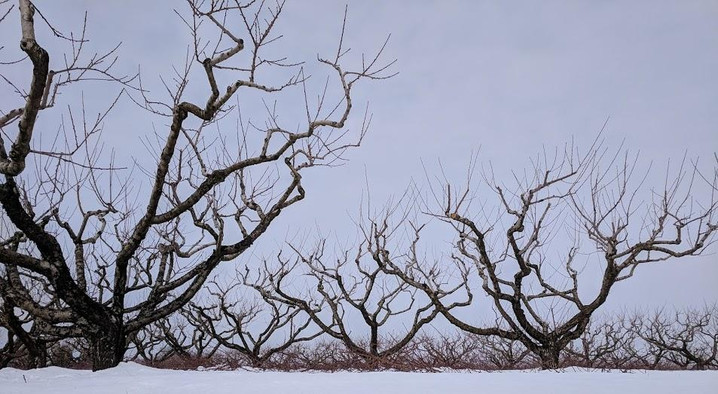Posted by Jeff Pauls & Clair Kauffman on 15th Mar 2019
Pruning the Orchard: Part Two of a Three Part Series
Last week, in Pruning the Orchard: Part One, we learned a little bit about the opportunity pruning affords our personnel to enjoy the wonders of fall and winter and some of our goals for pruning. In the next few paragraphs, our Orchard Manager gives us details on apical dominance, tree form, and sunlight.
Asked why we prune, our Orchard Manager, Clair Kauffman, responds with one word: Productivity. An unpruned fruit tree becomes less and less productive. Just what does a mature, productive tree look like? Pruning has been compared to carving a wood sculpture. If you’re carving a turtle, you need to get rid of everything that doesn’t look like a turtle. Applying this logic to pruning--dead wood, vertically growing wood, and branches that are very pendent or hanging downward are pruned. Branches that are extending horizontally from the main trunk or slightly upward fit the image of a productive fruit tree. The productive branches left on the tree benefit from all the energy that photosynthesis and the root system provide to the tree.
At this point, you might have a vague idea of what a healthy fruit tree looks like. However, more information will be helpful. When pruning, we train for tree form. This process begins when we plant. Its root stock is the first thing we consider. The tree is grafted onto rootstock at the nursery and helps determine the size of the fully-grown tree. A full-size standard tree has what they call a seedling rootstock that grew from seed. But today, virtually all apple trees in commercial production are grown on dwarfing rootstocks of some kind to limit the tree to a certain height. So, one variable for tree height is the choice of rootstock. It might also impart some disease resistance or pest resistance.
When we plant that tree, the early years are formative. We are careful how we prune to get the desired form in the shortest amount of time possible. Again, we are favoring certain parts of the tree. However, in this case, when we're thinking about the form of a tree, we’re thinking about what we call the central leader system. Also called its vertical axis. Our goal is a central trunk that grows to its ultimate height as fast as possible; even sometimes before full production in the rest of the tree. For the first couple years we’re interested in the growth of the central leader and not so much the growth of side branches. Once the tree has achieved a certain height, then we look for productivity in fruit. We favor the central leader, carefully pruning with it in mind. If there's something close to the top of the tree that's competing with it, we’ll trim it out. We want one dominant central leader.
Apple trees have what's called apical dominance. Whatever is on the end, or the apex, has dominance in the physiology of the tree. With more nutrients flowing to it, it grows faster. So, if two branches compete for apical dominance, they're robbing each other of nutrients. Whittling them down to one leader will give that leader the apical dominance, and it then grows faster toward its apex.
Another reason we prune the trees is for sunlight penetration. Raising fruit is really all about harvesting the Sun, because that’s where, really, most of the energy for the whole system is coming from. Photosynthesis is how trees create food. They don't really get their food from the soil, although, yes there's many things they do get in the soil, but not really the bulk of their food. They need to produce it from the Sun. Which means, the leaf surface is very important. How many of those leaves are actually in full sun and how many of them are shaded?
So in “carving the turtle,” we prune so that most of the leaves can be hit by the sun either morning or afternoon. The basic shape what we end up with is kind of a Christmas tree shape, so that none of the top branches shade out the bottom branches. The bottom branches are generally the widest so the sunlight can hit all of them on its way down. We also thin the branches out. Even too many of the right type of branches will hinder production because of shading. You need sunlight in there to get sugar production, resulting in growth. Shading means you don't get fruit size and you don’t get flavor; flavor is directly related to how much the sun touches those apples and the leaves around them. Every apple relates fairly directly with the leaves in its proximity. If leaves right around that apple aren't exposed to sunlight it is affected even if branches and other parts of the tree are getting plenty of sunlight. And sunlight penetration equals fruit coloring. The average consumer wants to see color.
Thanks for reading. When Clair compared pruning a tree to carving a turtle, at first I had to wonder what he meant. But after he explained it, it really made a lot of sense. Next week, in our final installment, Clair will describe how pruning enables a fruit tree to resist pests and diseases.

